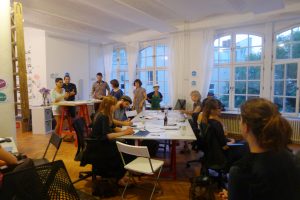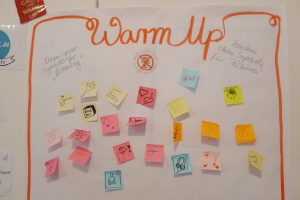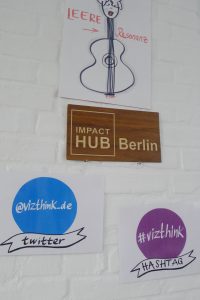Zum fünften vizthink Meetup in Berlin haben wir alle die Ohren aufgestellt. Wie ist das denn nun mit dem Zuhören? Worauf hören wir, wenn wir zuhören? Auf die Wort des Sprechers? Oder auf unsere eigene innere Stimme, die uns alles übersetzt? Und wie sehen wir Bilder von dem, was wir hören?
Location
Zu Gast waren wir dieses Mal im Impact HUB/ Agora Neukölln. Das Anliegen der Impact Hubs ist die Initiierung und Förderung von nachhaltigen Ideen und Projekten durch Innovation, Zusammenarbeit und Unternehmergeist.
Und Eindruck hat es auch auf uns gemacht. Wir fanden die location schön und haben uns in den Räumlichkeiten sehr wohl gefühlt. Danke noch einmal an das Team von Impact HUB, besonders an community host Moa Nilsson, die uns tatkräftig unterstützt hat.


Meetup
Los ging es mit unserem traditionellen Warm-up und der Vorstellungsrunde… und weiter zum Hauptthema des Abends. Conni Eybisch-Klimpel (Dipl.-Psych.) erzählte uns spannende Dinge über Hören, Zuhören und Visualisieren.


Visualisieren und Zuhören sind super mental skills – erst recht wenn wir sie kombinieren. Eine gute Vorbereitung aufs Zuhören hilft, besser zu visualisieren (also zu sketchnoten, graphic recorden, mitzuskribbeln). Wenn wir uns vor dem Zuhören klar machen, warum wir überhaupt zuhören bzw. was unser Auftrag ist, können wir uns vorab ganz viel zurechtlegen und das leere Blatt „einrichten“: mit einem Layout, einer Überschrift, Ort und Datum, Namen des Referenten und Logo oder Symbol, unter dem der Vortrag steht. Wir können uns eine passende Schrift und schon mal „visuelles Vokabular“ überlegen.


Dann kam die Gruppenübung: Wir sollten als Visual thinker entweder mit den Ohren von Politikberatern, Marketingberatern oder Verhaltenstrainern auf den Text des Songs „summertime“ hören und dann visualisieren. Was in die Ohren rein kam war überall das Gleiche, aber was aus den Stiften rauskam war sehr unterschiedlich.
Ein bisschen Psychologie
75 % unserer Wahrnehmungen sind visuell – und nicht etwa auditiv – abgespeichert.
Das Visualisieren von Gehörtem aktiviert Repräsentationen der gleichen Sache in verschiedenen Hirnarealen. Man nennt das den “Dual coding effect”.
Das “Denken in Bildern” erhöht unsere Absorptionsfähigkeit – wir vertiefen uns besser in das Gehörte und sind mehr (buchstäblich mit mehr Hirnarealen) beteiligt.
Antwort
Und so hatten wir am Ende des Abends eine beeindruckende Antwort auf die Frage: „How to listen?“:
Filter setzen – den Kopf leer machen – das Herz öffnen… zuhören… visualisieren.
Danke Conni!
(Buchtipps: Austin Kleon „Show your work“; Mike Rohde: “The Sketchnote Handbook”)


Fotos und Meetup #6
Alle Fotos vom Berliner Meetup #5 gibt’s auf flickr.
Berlin Meetup # 6 findet im Oktober in der BMW-Stiftung statt. Bis bald!
Doris, Naho, Conni, Wiebke und Sylvia
///
Follow up: vizthink meetup #5 Berlin – How to listen?
For the fifth time Berlin community for visual thinkers met. This time to answer the question: How to listen?
Location
We were guests of Impact HUB at the Agora in Berlin-Neukölln.
Impact Hubs are designed to facilitate the creation of sustainable impact through collaboration. We want HUB Berlin to happen – a space driven by an innovative, collaborative and entrepreneurial spirit that aims to make sustainable impact.
And an impact it made on us as well. We liked the location a lot and felt quite comfortable. Our warmest thanks to the team from Impact HUB especially to community host Moa Nilsson, who looked after us so kindly.
Meetup
As usual we started with a good warm up exercise and an introduction round… and went straight on to the theme of the evening. Conni Eybisch-Klimpel (Dipl.-Psych.) told us exciting facts about hearing, listening and visualizing.
Visualizing and listening are super mental skills – even more if we combine them. The better we are prepared to listen, the better we visualize, sketch note, record and scribble. To be clear about what is the purpose of our attention enables us to setup the sheet we’re about to work on: giving it a layout structure, a headline, place and date, write down the name of the speaker or draw a logo or symbol of the lecture. We can beforehand choose pens and pencils and a matching “visual vocabulary”.
Our group exercise: As visual thinkers we should listen to the song “summertime” pretending to be consultants for politics, marketing consultants, coaches for social professions… and start visualizing. What entered our ears was the same for everyone, but what came out of our pens was quite different.
Psychology
75 % of our cognition is visual – not auditive – stored.
Visualization of the things heard activates representations of the same thing in different areas of the brain. It’s called “Dual coding effect”.
„Thinking in pictures“ increase our ability to absorb. We delve into what we listen to and are deeper (and literally with more brain areas) involved.
Answer
And at the end of the evening we had an answer to the question “How to listen?”:
Set your filters – open your brain – open your heart… start listening… start visualizing.
Thanks Conni!
(Recommended books: Austin Kleon „Show your work“; Mike Rohde: “The Sketchnote Handbook”)
Fotos
All photos of our Berlin Meetup #5 at flickr.
Berlin Meetup # 6 will be in October 2014 at the BMW-foundation. See you soon!
Doris, Naho, Conni, Wiebke und Sylvia
Comments are closed